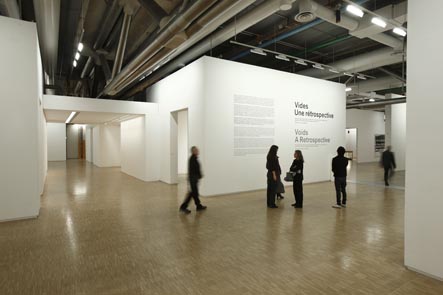
VOIDS, Eine Retrospektive, Kunsthalle Bern - 13/09 - 11/10 2009 - opening 12/09 - 18.30pm
VIDES, Une Rétrospective, Centre Pompidou, Paris - 25 Février / 23 Mars 2009
VOIDS, A Retrospective / Leeren, A Retrospective

VOIDS, EINE RETROSPEKTIVE
Kunsthalle Bern – 13.09 – 11.10 2009
With VOIDS, EINE RETROSPEKTIVE the Kunsthalle Bern offers an opportunity to explore a crucial chapter in the history of art. Following Yves Klein’s exhibition at the Iris Clert gallery in 1958, the empty space became a recurrent artistic theme. This chronological retrospective exhibition brings together nine empty exhibitions by Yves Klein, Art & Language, Robert Barry, Robert Irwin, Stanley Brouwn, Bethan Huws, Maria Eichhorn, and Roman Ondák.
Yves Klein’s 1958 emblematic exhibition ‘The Specialization of Sensibility in Raw Material State into Stabilized Pictorial Sensibility’, which was subsequently referred to as The Void, is widely considered as a turning point in modern art history. The empty space exhibited as such thus became, in a way, a classic of radicalism, and would be repeated and remade in other contexts, other places and other times by other artists whose intentions might be similar, different or even opposed to Klein’s.
The principle of the exhibition at the Kunsthalle Bern is to present only exhibitions where the space is left rigorously empty, without the addition or subtraction of anything, thus excluding, for instance, shows or works involving the modification of lighting, the installation of sound, the construction of partitions or the exclusion of the public. And it is no part of its goal to reconstruct the original physical space, as rather than representing the historical void by the artists, the retrospective - working closely with the artist and their estate - considers the void itself, and not the architecture that hosted the void.
Also, all forms of historical documentation or memorabilia related to the original exhibition (such as posters, photos, invitations, photo-documentation, press reviews, original texts) are excluded from the exhibition; all such elements being included in the exhaustive catalogue published alongside the exhibition, edited by the curators John Armleder, Mathieu Copeland, Mai-Thu Perret, Clive Phillpot, Gustav Metzger, together with Laurent Le Bon and Philippe Pirotte.
Each void offers a different reading of the empty space, representing, perhaps, a claim, a renunciation, or, indeed, a celebration of the museum or gallery’s space. Contemplating emptiness, one confronts nothingness and absence, the invisible and the ineffable, destruction and negation. VOIDS are offered for what they are, and for what they allow. This accumulation of empty spaces, similar in appearance but radically different in reality, has echoes and implications beyond its walls. More than a radical and conceptual exhibition, the retrospective is an invitation to explore and experience, in a very physical manner, the different texture of each different space. The visitor encounters the empty exhibitions now in 2009, exactly 40 years after ‘When Attitude Become Form’ organised by Harald Szeeman when director of the Kunsthalle Bern. It was such exhibition that enabled this retrospective to be, and one could dream that with the voids, the attitudes, literally, are the forms.
This exhibition brings together the work of artists who have attempted this extreme gesture, to exhibit without showing an object, without making any intervention but a single announcement. The exhibition begins with Yves Klein’s 1958 exhibition, and from then on envisages how entirely empty exhibitions have defined different kinds of emptiness, sometimes as a means to signal sensibility as for Klein, sometimes as the peak of a conceptualist or minimalist practice as with Robert Barry’s ‘Some places to which we can come, and for a while “be free to think about what we are going to do (Marcuse)”’ (1970). Sometimes as the desire to explore our understanding of exhibition & exhibition spaces as for Art & Language’s ‘Air Conditioning Show’ (1966-67), or in the case of Robert Irwin’s ‘Experimental Situation’ (1970) as the appraisal of the space, and the affirmation that there is no such thing as nothing. Sometimes as the desire to empty an institution & focus on the experience of walking through it as for Stanley Brouwn, or with Laurie Parsons’ exhibition at the Lorence-Monk Gallery in New York in 1990, announced by a card bearing only an address, with neither dates nor the name of the artist, as a means to announce the artist’s complete withdrawal. Sometimes as the affirmation that there is no need to introduce in a space a work of art as it is already there, as with Bethan Huws’ ‘Haus Esters Piece’ (1993). And again as with Maria Eichhorn’s ‘Money at the Kusnthalle Bern’ who in emptying the Kusnthalle in 2001 worked with the void out of necessity, devoting the exhibition budget to the renovation of the building. And sometimes it is the means to remind us that the most important aspect of any void is the notion of trust and belief, as with Roman Ondak’s ‘More Silent Than Ever (room fitted with eavesdropping devices)’ (2006), a piece that deceives the public in making one believe that there is more when indeed there is nothing.
In this respect, from the search for a renewal of perception, through political or ideological statement, to the deconstruction of the very principle of exhibition, these exhibitions pose a range of crucial questions about the role of the institution, and this unprecedented marshalling of eloquent emptiness within the Kunsthalle Bern represents a true challenge to the institution.
For an unprecedented exhibition, a unique curatorial team. VOIDS, A RETROSPECTIVE, which is both an exhibition in the most traditional sense and an art event in its own right, has been put together by John Armleder, who has always been interested in nothing; Gustav Metzger, a key figure in auto-destructive art, Mai-Thu Perret, a young conceptual artist, Mathieu Copeland, a curator who explores the limits of the exhibition, Clive Phillpot, a writer; together with Philippe Pirotte, director of the Kunsthalle Bern.
Accompanying and simultaneously to the retrospective at the Kunsthalle Bern, the Museum Haus Lange, Krefeld, will be entirely empty and open to the public for a week (20th - 27th of September) as an invitation to visit Yves Klein’s ‘Raum der Leere’, a permanent void realized in 1961.
Accompanying events will also include an evening of performance by Ben Vautier, a screening of films curated by Stuart Comer, a listening session by Francis Baudevin, and "Absenz - (k)ein konzert" a concert by Ensemble Neue Horizonte. For more information on dates and locations in Bern on all these events, please refer to www.kunsthalle-bern.ch.
VOIDS, EINE RETROSPEKTIVE is coproduced by the Centre Pompidou, Paris, and the Kunsthalle Bern.
VIDES, Une rétrospective
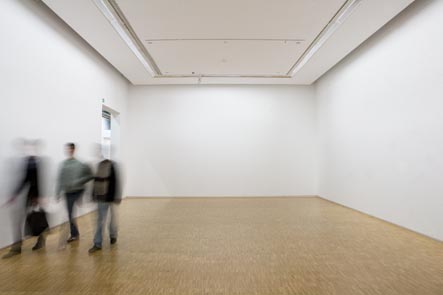
Manifestation exceptionnelle, « Vides » est une rétrospective des expositions vides depuis celle d'Yves Klein en 1958. Dans une dizaine de salles du Musée national d'art moderne, elle rassemble, de manière inédite, des expositions qui n'ont rigoureusement rien montré, laissant vide l'espace pour lequel elles étaient pensées.
L'idée d'exposer le vide est récurrente dans l'histoire de l'art de ces cinquante dernières années, au point d'être presque devenue un cliché dans la pratique artistique contemporaine. Depuis l'exposition d'Yves Klein La spécialisation de la sensibilité à l'état matière première en sensibilité picturale stabilisée à la galerie Iris Clert, à Paris, en 1958, les expositions entièrement vides affirment différentes conceptions du vide.
S'il est pour Yves Klein un moyen de signaler l'état sensible, il représente en revanche l'apogée de l'art conceptuel et minimal pour Robert Barry avec Some places to which we can come, and for a while "be free to think about what we are going to do." (Marcuse), [« Des lieux où nous pouvons venir, et pour un moment, ' être libre de penser à ce que nous allons faire '. (Marcuse) »], œuvre initiée en 1970. Il peut aussi résulter du désir de brouiller la compréhension des espaces d'expositions, comme dans l'œuvre The Air-Conditioning Show d'Art & Language (1966-1967), ou de vider une institution pour modifier notre expérience comme dans l'oeuvre de Stanley Brouwn.
Il traduit également la volonté de faire l'expérience des qualités d'un lieu d'exposition, comme pour Robert Irwin et son exposition réalisée à la ACE Gallery en 1970, ou pour Maria Nordman lors de son exposition à Krefeld en 1984. Le vide représente aussi une forme de radicalité, comme celui créé par Laurie Parsons en 1990 à la galerie Lorence-Monk, qui annonce son renoncement à toute pratique artistique. Pour Bethan Huws et son œuvre Haus Esters Piece (1993), le vide permet de célébrer l'architecture du musée, signifiant que l'art y est déjà présent et qu'il n'est pas nécessaire d'y ajouter des œuvres d'art. Le vide revêt presque le sens d'une revendication économique pour Maria Eichhorn qui, laissant son exposition vide à la Kunsthalle Bern en 2001, permet d'en consacrer le budget à la rénovation du bâtiment. Avec More Silent than Ever (2006), Roman Ondak, quant à lui, laisse croire au spectateur qu'il y a plus que ce qui est laissé à voir.
Comité Curatorial : John Armleder, Mathieu Copeland, Gustav Metzger, Mai-Thu Perret, Clive Phillpot.
Commissaire au Centre Pompidou: Laurent Le Bon
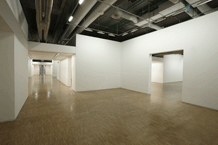
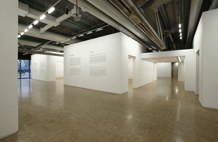
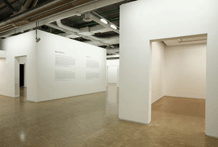
VIDES. Une rétrospective. Toutes les photographies © Centre Pompidou, Georges Meguerditchian, 2009
VOIDS
Voids. A Retrospective is a paradoxical exhibition: by re-actualizing nine “empty exhibitions,” it is simultaneously an experimental project that refuses the classic rules of the visual arts and an historical object which confronts the projects of Art & Language, Robert Barry, Stanley Brouwn, Maria Eichhorn, Bethan Huws, Robert Irwin, Yves Klein, Roman Ondák, and Laurie Parsons.
At once the support and an extension of the event, this publication outlines the concept of the void in art, aesthetics, philosophy, religion, science, popular culture, architecture, and music, and broaches the subject of nothing, of vacuity, of the invisible and the ineffable, of rejection and destruction.
Opening with a catalogue section that documents the nine selected historical and contemporary exhibitions, the publication also contains an anthology of more than forty texts, many published here for the first time, as well as contributions by artists created especially for this volume.
Essays by Benjamin Buchloh, Jean-François Chevrier, Stuart Comer, Lucy Lippard, Bob Nickas, Brian O'Doherty, Sadie Plant, Ralph Rugoff, Jon Savage, and Sarah Wilson thus intersect with interviews conducted with Robert Barry, Morgan Fisher, Claude Parent, and Jacques Villeglé, and the propositions of Peter Downsbrough, Dominique Gonzalez-Foerster, Wade Guyton, Hans Haacke, Sherrie Levine, Malcolm McLaren, Olivier Mosset, Yoko Ono, Sturtevant, and Lawrence Weiner.
Through the rich documentation, as well as the texts by specialists on the subject, this book proposes an evaluation of the origins, the mechanisms, and the resonances of this major artistic gesture consisting of emptying the exhibition space rather than filling it.
Edited by Mathieu Copeland with John Armleder, Laurent Le Bon, Gustav Metzger, Mai-Thu Perret, Clive Phillpot and Philippe Pirotte.
Publié avec le Centre Pompidou, Paris, et la Kunsthalle Bern.
2009
édition française et anglaise
21,5 x 28 cm (broché)
540 pages (100 ill. coul. et 200 ill. n&b)
39 €ISBN : 978-3-03764-017-3EAN : 9783037640173
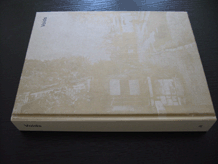
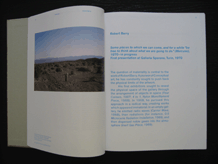
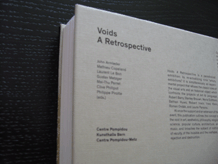
VIDES
Vides. Une rétrospective est une exposition paradoxale : à travers la réactualisation de neuf «expositions vides», elle apparaît simultanément comme un projet expérimental qui refuse les règles classiques des arts visuels et comme un objet historique qui confronte les réalisations de Art & Language, Robert Barry, Stanley Brouwn, Maria Eichhorn, Bethan Huws, Robert Irwin, Yves Klein, Roman Ondák et Laurie Parsons.
Support et prolongement de la manifestation, cet ouvrage dessine les contours du concept de «vide» dans l'art, l'esthétique, la philosophie, la religion, les sciences, la culture populaire, l'architecture et la musique, en abordant les problématiques du rien, de la vacuité, de l'invisible et de l'ineffable, du rejet et de la destruction. S'ouvrant sur un catalogue qui documente les neuf expositions historiques et contemporaines retenues, le livre comporte également une anthologie d'une quarantaine de textes, souvent inédits, ainsi que des contributions d'artistes spécialement réalisées pour l'ouvrage. Les essais de Benjamin Buchloh, Jean- François Chevrier, Henry Flynt, Lucy Lippard, Bernard Marcadé, Anne Moeglin-Delcroix, Brian O'Doherty, Sadie Plant, Didier Semin, David Toop ou Sarah Wilson s'entrecroisent ainsi avec des entretiens réalisés avec Robert Barry, Ben, Morgan Fisher, Claude Parent ou Jacques Villeglé, et les propositions de Peter Downsbrough, Dominique Gonzalez-Foerster, Wade Guyton, Hans Haacke, Sherrie Levine, Malcolm McLaren, Olivier Mosset, Sturtevant ou Lawrence Weiner.
À travers la riche documentation et les textes de spécialistes réunis, cet ensemble se propose d'évaluer les origines, les dispositifs et les résonances de ce geste artistique capital, consistant à vider l'espace d'exposition plutôt qu'à le remplir
Edité par Mathieu Copeland avec John Armleder, Laurent Le Bon, Gustav Metzger, Mai-Thu Perret, Clive Phillpot et Philippe Pirotte.
Published by Centre Pompidou, Paris, and Kunsthalle Bern.
2009
édition française et anglaise
21,5 x 28 cm (broché)
540 pages (100 ill. coul. et 200 ill. n&b)
39 €ISBN : 978-3-03764-017-3EAN : 9783037640173
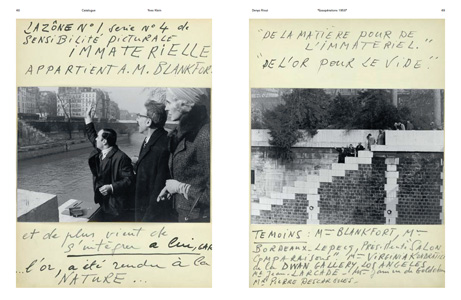
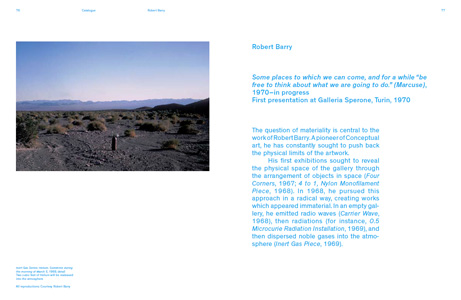
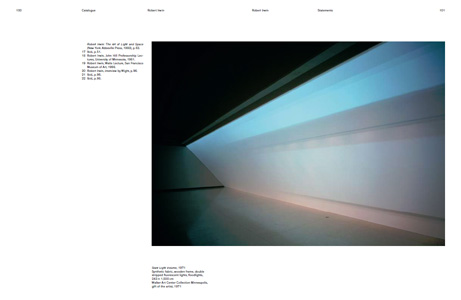
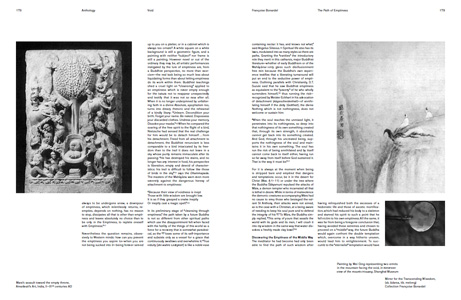
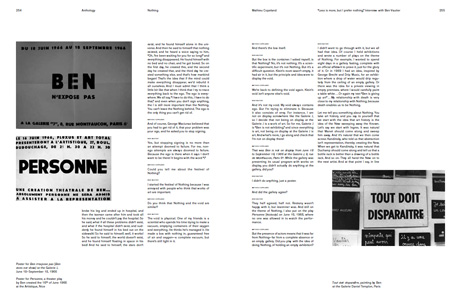
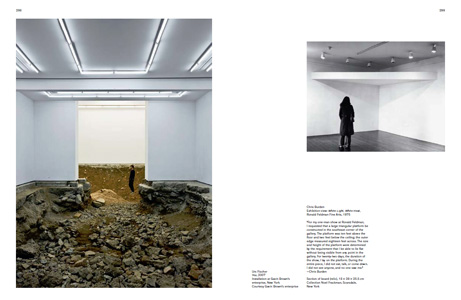
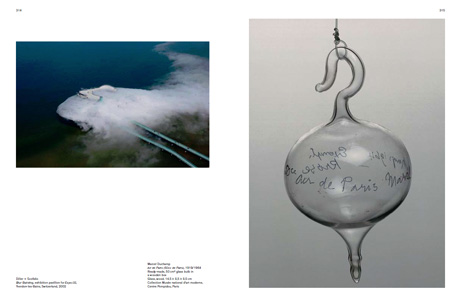
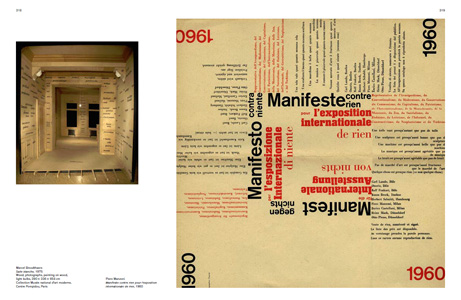
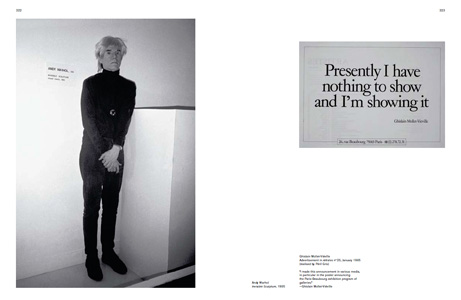
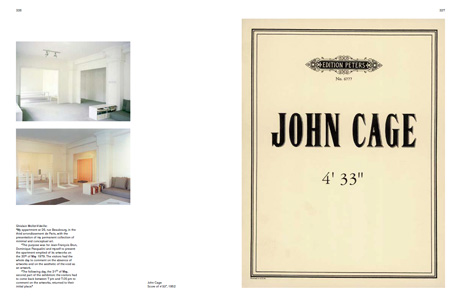
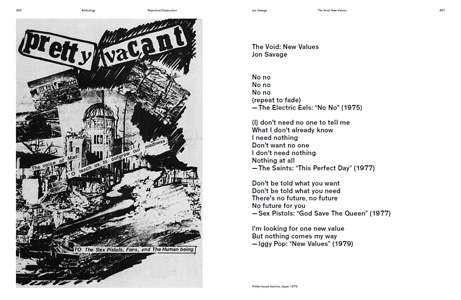
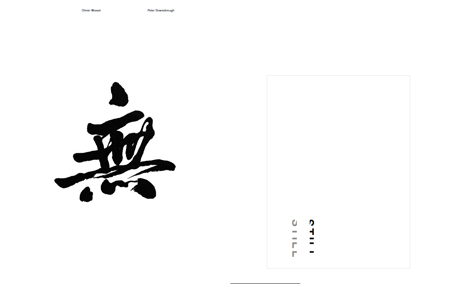
VOIDS: LE SYMPOSIUM
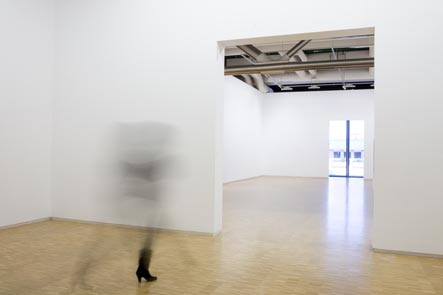
In connection with the exhibition: “Voids: a retrospective”
WEDNESDAY 25 FEBRUARY, 7.30 PM, PETITE SALLE
Admission free, subject to availability
“Voids: A retrospective,” the first exhibition of its kind, brings together in the Musée National d'Art Moderne the work of nine artists who have chosen to show empty spaces – the pioneer being Yves Klein, with his exhibition at the Iris Clert gallery in 1958. It includes projects by Klein, Art & Language, Robert Barry, Robert Irwin, Laurie Parsons, Bethan Huws, Maria Eichhorn, Roman Ondák and Stanley Brouwn.
If all these artists showed nothing, leaving the space completely unaltered, the meaning they attached to the gesture differed in each case. Whether seeking to heighten awareness or to sharpen perception, to make a political or ideological statement, to promote philosophical or theoretical reflection, or to deconstruct the very idea of exhibition, their varying use of the empty space in these apparently similar exhibitions raises a host of often complementary questions that present a radical challenge to the function and legitimating authority of the institutions of art.
The symposium is thus a necessary pendant to this unique retrospective, offering an opportunity to articulate and explore these interrogations together with the curators and a number of the exhibited artists.
Among the speakers will be artists Robert Barry, Bethan Huws and Roman Ondák, philosopher of religion Françoise Bonardel, and co-curators John Armleder, Laurent Le Bon, Mathieu Copeland, Gustav Metzger, Mai-Thu Perret and Clive Phillpot.
Vides. Le symposium.
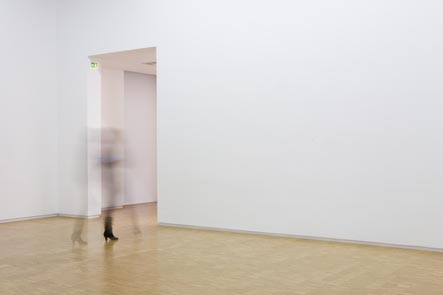
Avec, entre autres invités : Robert Barry, Françoise Bonardel, Bethan Huws, Roman Ondák ; et les commissaires de l'exposition John Armleder, Laurent Le Bon, Mathieu Copeland, Gustav Metzger, Mai-Thu Perret et Clive Phillpot.
Manifestation exceptionnelle, « Vides » est une rétrospective des expositions vides depuis celle d'Yves Klein en 1958. Dans une dizaine de salles du Musée national d'art moderne, elle rassemble de manière inédite des expositions qui n'ont rigoureusement rien montré, laissant vide l'espace pour lequel elles étaient pensées.
Si toutes ces expositions dont il est fait la rétrospective ont en commun d'avoir fait le choix du vide, elles se différencient par la signification qu'elles lui attribuent. D'Yves Klein à Roman Ondák, en passant par Robert Barry, Art & Language ou encore Maria Eichhorn, chacun des artistes présentés illustre, de différentes manières, souvent complémentaires, le désir de travailler le vide.
De la recherche de sensibilité ou de perceptions inédites à la mise en abyme du principe même d'exposition, de la prise de position politique ou idéologique à la réflexion philosophique, cet ensemble d'expositions, d'apparence similaire, propose une constellation radicale de questionnements et de contestations sous forme de défis à l'institution sacralisante.
Cette rencontre est donc le pendant nécessaire de cette étonnante rétrospective puisqu'elle permettra à ces questionnements de s'expliciter et de se confronter grâce aux interventions et aux discussions menées tout à la fois par des artistes de la rétrospective et par les commissaires.
25 février 2009 - 19h30
Centre Pompidou
Place Georges Pompidou
75004 Paris